-
PDF
- Split View
-
Views
-
Cite
Cite
G. B. CARBNO, D. CANIL, Mantle Structure Beneath the SW Slave Craton, Canada: Constraints from Garnet Geochemistry in the Drybones Bay Kimberlite, Journal of Petrology, Volume 43, Issue 1, January 2002, Pages 129–142, https://doi.org/10.1093/petrology/43.1.129
Close - Share Icon Share
Abstract
This study describes the petrography of peridotite xenoliths, and the major and trace element geochemistry of garnets in both xenoliths and coarse concentrate from the Drybones Bay kimberlite. The temperature and depth of equilibration of clinopyroxene and garnet show that the mantle lithosphere beneath the SW margin of the Slave Province was at least 160 km thick at the time of kimberlite emplacement (∼450 Ma). The garnet population is dominated by grains with sinuous light rare earth element (LREE)-enriched trace element patterns many of which are ultra-depleted in Zr, Y and Ti. Normal heavy REE (HREE)-enriched garnets make up a small proportion of the garnet population. The spectrum in garnet geochemistry may be explained by heating and percolation of a metasomatic fluid from through an ultra-depleted mantle protolith before kimberlite eruption. A shallow ultra-depleted layer of mantle lithosphere recognized in garnets from the central Slave Province may exist beneath the SW margin of the craton, but the layer has been modified or overprinted by the metasomatic front, which has caused enrichment in Ca and incompatible elements in garnets. The changes in garnet chemistry in the Drybones Bay garnets are coincident with a unique seismic discontinuity exhibiting multiple layer anisotropy commencing at 110 km depth ∼50 km north of Drybones Bay; correlation of the two features is, however, tenuous.
INTRODUCTION
Seismic tomography and teleseismic methods show evidence for a cool mantle root beneath the Archean Slave Province (Bostock, 1998). The Drybones Bay kimberlite is located along the SW margin of the Slave Province (62°15′N, 114°00′W; Fig. 1) and is of particular interest because it contains mantle xenoliths for comparison with a larger petrological database for mantle samples from the central regions (Boyd & Canil, 1997; Kopylova et al., 1998; Griffin et al., 1999a; MacKenzie & Canil, 1999; Kopylova & Russell, 2000). Those studies confirm the existence of a deep lithospheric mantle root beneath the Slave Province but the extent and characteristics of the root towards the externides of the craton, as reflected in surface geology, are not known. This information is central to models of the deep structure of cratons, diamond exploration and the overall evolution of Archean continents. Furthermore, the Drybones Bay kimberlite pipe is in close proximity to the YKA teleseismic array (Bostock, 1998), electromagnetic (Jones et al., 2001) and deep seismic reflection surveys (Cook et al., 1998), and the only published surface heat flow measurement for the Slave Province (Lewis & Wang, 1992) (Fig. 1). For these reasons, the Drybones Bay kimberlite affords an unprecedented opportunity to compare petrological and geochemical information from mantle material with a diverse array of nearby geophysical measurements of the lithosphere beneath an Archean craton.
Geological map of the Slave Province showing the locations of the Drybones Bay and other kimberlite pipes mentioned in the text (⧫) [adapted from MacKenzie & Canil (1999)]. Also shown are the locations of the YKA teleseismic array (Bostock, 1998), the LITHOPROBE SNORCLE line 1 transect (Cook et al., 1998) and the Pb isotope boundary recognized in galenas from crustal rocks (Thorpe et al., 1992).
This study describes the petrography of peridotite xenoliths from the Drybones Bay kimberlite, and the major and trace element geochemistry of peridotitic garnets and clinopyroxenes in both the xenoliths and coarse concentrate. Garnets are the focus of the study because they show no sign of alteration in the Drybones Bay kimberlite. Lithospheric thickness and structure are deduced, and some questions bearing on the protolith and processes involved in the formation of lithosphere are addressed in the geochemical patterns recorded by the garnets. These data provide some constraints on lateral and vertical changes in the cratonic lithosphere toward the edge of the Slave Province, and may also furnish a means to compare geophysical and petrological interpretations of lithosphere beneath an Archean craton.
GEOLOGY
The Archean Slave Province is composed of granites, gneisses and supracrustal rocks. The supracrustal sequences are dominated by metasedimentary and lesser metavolcanic rocks of the Yellowknife Supergroup dated at 2·71–2·61 Ga. Several generations of granitoid plutons (2·5–2·8 Ga) cover ∼65% of the region (Padgham & Fyson, 1992).
The Drybones Bay kimberlite pipe is located beneath Drybones Bay on the north shore of Great Slave Lake (Fig. 1). The pipe has U–Pb zircon age of 442–485 Ma (L. Heaman, personal communication, 1997) and intrudes plutons of the Archean Defeat Plutonic Suite (2620 Ma). The kimberlite includes crater, reworked crater (epiclastic) and diatreme facies, the extent and geometry of which are only defined by very limited drilling (U. Kretschmar, personal communication, 1997).
SAMPLES
A total of 17 mantle-derived xenoliths [seven garnet peridotites; three spinel peridotites; two spinel–garnet peridotites; one pyroxenite; one Mica–Amphibole–Rutile–Ilmenite–Diopside (MARID); three eclogites] were recovered from ∼100 m of 8 cm drill core. Only the peridotite samples are the subject of this study. In addition, hundreds of garnet grains and seven garnet–clinopyroxene pairs were also recovered in heavy mineral coarse concentrate of kimberlite drill core from several locations within the pipe.
PETROGRAPHY
Petrographic details of the samples are provided in the Appendix. In the studied section, the peridotite xenoliths from the Drybones Bay kimberlite range in area from 0·7 to 8·5 cm2.
With the exception of garnet and spinel, all other primary minerals are completely altered to serpentine or carbonate. Certain characteristics of the pseudomorphs evident in plane-polarized light were found to be useful in distinguishing the original mineralogy and textures. Serpentinized grains that have fractures and no cleavage are pseudomorphs of olivine, whereas grains with relict cleavage are pseudomorphs after pyroxenes (Fig. 2). In a few heavily carbonatized samples, however, grain boundaries are not well preserved and differentiating pyroxene and olivine was impossible. In some samples, carbonate replaces grains that are small, and it could be assumed that clinopyroxene was the primary phase, because orthopyroxene is usually coarse in cratonic xenoliths (Boyd & Mertzman, 1987). For modal analysis, all grains with relict cleavage were considered simply as pyroxene, because of the lack of confidence in applying grain size to differentiate ortho- from clinopyroxene. All of the peridotite xenoliths have a coarse texture (Harte, 1977) with an average grain size >2 mm. Many of the xenoliths have secondary phlogopite and opaque minerals in fractures, fissures or as mantles on garnet grains.
Photomicrograph of spinel–garnet peridotite xenolith in plane-polarized light. Spinel and garnet remain unaltered, whereas olivine and pyroxene have been completely serpentinized. The relict cleavage in the serpentinized pyroxene grains that makes them distinguishable from serpentinized olivine should be noted.
Modal data for nine samples were obtained by point counting 1500–7500 points, depending upon sample size. An appropriate grid spacing was chosen to minimize counting errors (Solomon, 1963) estimated to be 15% relative (at 2σ) in modal abundances of olivines, pyroxene and garnet. The modal data reveal positive and negative correlations of modal olivine and garnet, respectively, with sample size (Fig. 3). This correlation has been recognized in a detailed petrographic study of other coarse, cratonic mantle xenoliths and signifies a close spatial relationship of garnet and pyroxene in an olivine-rich matrix (Cox et al., 1987). Cox et al. (1987) recommended modal estimations with minimum areas of ∼7–8 cm2 to eliminate this spatial bias in typical coarse, cratonic xenoliths. Extrapolation of the trend for the Drybones Bay xenoliths to this minimum area would suggest a mantle mineralogy with greater than ∼75% olivine beneath Drybones Bay, but this value is obviously not well constrained by the relatively few xenoliths available for study in the Drybones Bay pipe.
Plot of xenolith size against combined modal percent of pyroxene and garnet for mantle xenoliths from the Drybones Bay pipe determined by detailed point counting. With increasing area of the sample in thin section, modal pyroxene + garnet decrease and modal olivine increases. Also shown for comparison are petrographic data for mantle peridotites in the Grizzly and Torrie kimberlites (Boyd & Canil, 1997; MacKenzie & Canil, 1999).
ANALYTICAL METHODS
Major and minor element compositions for garnet and clinopyroxene were determined by wavelength-dispersive analysis using a CAMECA SX-50 electron microprobe at the University of British Columbia (UBC) and a JEOL JXA 8900 electron microprobe at the University of Alberta (U of A). Mineral grains were analysed at an accelerating voltage of 15 kV and a 20 nA beam current with peak-counting times of 20 s for both major and minor elements. Instrument calibration was performed on natural and synthetic standards. Previous work has shown identical results for these two microprobe laboratories (MacKenzie & Canil, 1999). In xenolith samples, two or four grains of each mineral (garnet or spinel) were analysed, and on each of the grains two to four points (depending on grain size) were analysed to determine homogeneity on both a mineral and xenolith scale. In coarse concentrates two to three points for each garnet or clinopyroxene grain were analysed. Average mineral compositions are given in Electronic Appendix Table 1, as all garnets and pyroxenes show no sign of significant major element heterogeneity. This table may be downloaded from the Journal of Petrology Web site at http://www.petrology.oupjournals.org.
Garnet and clinopyroxene grains from heavy mineral concentrate and garnets from five xenoliths were analysed for 26 trace elements by laser ablation inductively coupled plasma mass spectrometry (LA-ICP-MS) using a Merchantek EO UV Nd:YAG laser coupled to a high-sensitivity VG PQII S instrument at the University of Victoria (UVic). Laser spot size ranged from 50 to 70 μm using a power output of 0·75–2·19 mJ and a pulse rate of 10·0 Hz. Other operation details have been reported elsewhere (Chen, 1999). For garnets in concentrate, one to two spots for each grain were analysed. In each peridotite xenolith, multiple garnets and often more than six points per single grain were analysed. The data are given in Electronic Appendix Table 2, which may be downloaded from the Journal of Petrology Web site at http://www.petrology.oupjournals.org.
Data for all trace elements were collected with PQVision 4.36 Time Resolved Analysis software and exported offline for further processing using in-house software (Chen, 1999; Chen et al., 2000). NIST 613 synthetic silicate glass (Chen et al., 1997) was used as an external calibration standard (Electronic Appendix, Table 2) with Ca as an internal standard to correct for drift, matrix effect, changes in laser sampling yield and transport efficiency during the analysis. Tests of precision for this instrument over a 1 year period on BCR-2 glass standard are 5% or better for all elements analysed. Accuracy based on analysis of BCR-2 glass is better than 10% for all elements except Ti (10%) and Sc (20%). Although the accuracy and precision of the LA-ICP-MS technique used here has been tested on three glass standards (Chen, 1999; Chen et al., 2000) it is also important to compare results on mantle minerals. Shimizu et al. (1997) and Shimizu (1999) reported secondary ion microprobe (SIMS) data on a mantle garnet (UV417/89) that has been analysed in the UVic LA-ICP-MS laboratory. This garnet is homogeneous for most trace elements except Sr. The SIMS and UVic LA-ICP-MS analyses compare within 20% for Zr, Y and the REE (Electronic Appendix, Table 2). In addition, a large homogeneous mantle garnet (Sample 21-6, Kopylova et al., 1998) with Ni determined by a proton microprobe instrument (PMP) with accuracy for Ni that is well demonstrated (Campbell et al., 1996) was used as an external check. Garnet 21-6 was analysed for Ni during every analytical run, and gave results within 10% of the PMP value, thus showing further accuracy of the LA-ICP-MS data for Ni in garnet. All elements reported in Electronic Appendix Table 2 are above limits of detection, defined by three standard deviations of the background counts for each element. Detection limits for LA-ICP-MS depend on sample quality, but ‘typical’ values obtained for mantle garnets in the UVic laboratory are shown in Electronic Appendix Table 2.
MAJOR ELEMENT GEOCHEMISTRY
Garnet
A plot of the CaO and Cr2O3 contents of garnets from Drybones Bay peridotite xenoliths and heavy mineral concentrates (Fig. 4) shows that the suite is dominated by wehrlite and lherzolite, with a few samples plotting near the harzburgite ‘field’, although in detail the levels of Ca saturation, and thus the boundaries of this classification scheme, can change with P, T and composition (Brenker & Brey, 1997). Some harzburgites are known to plot in the lherzolite field (e.g. Kopylova et al., 1998) and two clinopyroxene-saturated garnets (from pairs in this study) plot within the harzburgite field (Fig. 4). Many of the garnets from the Drybones Bay kimberlite define a unique compositional trend characterized by subdued Cr levels for a given Ca abundance (Fig. 4), which is thought to be indicative of garnets derived from spinel–garnet peridotites (Kopylova et al., 2000). This inference is also supported here by the fact that many of the garnets from spinel–garnet peridotite xenoliths in the Drybones Bay suite also plot along this vector. Some of the garnets within the ‘spinel–garnet’ trend also plot within the wehrlite field and are probably derived from orthopyroxene-free or orthopyroxene-poor lithologies.
Plot of the CaO vs Cr2O3 content of Drybones Bay garnets, with fields labelled after Dawson & Stephens (1975). The Drybones Bay garnets are primarily lherzolitic and wehrlitic, with a few samples possibly being harzburgitic. Dashed line (‘sp–gt’) is the trend in garnet compositions recognized in spinel–garnet peridotites (Kopylova et al., 2000). It should be noted that all xenolith samples from this study plot along the ‘sp–gt’ trend.
Clinopyroxene
Clinopyroxenes in the garnet–clinopyroxene pairs from heavy mineral concentrate are Cr diopsides (0·87–4·2 wt % Cr2O3) with Mg/(Mg + Fe) ranging from 03·896 to 0·951, and contain from 1·1 to 3·8 wt % Na2O.
TRACE ELEMENT GEOCHEMISTRY
Garnet
Two distinct types of garnets from Drybones Bay are recognized on the basis of their chondrite-normalized trace element patterns: garnets with normal heavy rare earth element (HREE)-enriched patterns, herein termed ‘N-type’, and garnets with sinuous REE patterns, termed ‘S-type’ (Fig. 5). The N-type garnets show depletion in the light REE (LREE), steady enrichment from SmN to YbN (where the subscript N indicates chondrite normalized) and are less frequent in the entire garnet population (Fig. 5). The S-type pattern is recognized in the vast majority of coarse concentrate garnets, and is characterized by enrichment in SmN over DyN, fairly flat trends between the HREE, and (Nd/Y)N much greater than unity (Pearson et al., 1998b). The S-type pattern is commonly recognized in harzburgitic garnets [reviewed by Stachel et al. (1998)]. Garnets from garnet–clinopyroxene pairs generally have REE patterns that are intermediate in shape to the N- and S-type end members, but show enhanced levels of Sr, LREE, Ti, Zr and Hf (Fig. 5b).
Representative chondrite-normalized trace element patterns for garnets from the Drybones Bay coarse concentrate (a) and from xenoliths and garnet–clinopyroxene pairs (b). Specific samples are labelled as typical normal (N-type) and sinuous (S-type) patterns.
Clinopyroxene
Clinopyroxenes from garnet–clinopyroxene pairs all have LREE-enriched trace element patterns (Fig. 6) and depletions in Y that are complementary to the enrichment of this element in coexisting garnets (Fig. 5b). They also exhibit levels of LREE enrichment (10–100 times chondrite) that have been suggested to have been caused by metasomatism by carbonate melts (Ionov, 1998; Norman, 1998).
Chondrite-normalized trace element abundances for clinopyroxenes from garnet–clinopyroxene pairs in Drybones Bay coarse concentrate.
THERMOBAROMETRY
With the exception of seven garnet–clinopyroxene pairs, the absence of multiple phases coexisting with garnet prevents the use of conventional peridotite geothermobarometers to estimate the pressure and temperature of origin for the Drybones Bay samples. A Ni-in-garnet geothermometer (TNi) calibrated by experiment (Canil, 1990) is used to estimate temperatures for the garnets (Electronic Appendix, Table 3). An empirical version of this thermometer (TNi-Ryan) was also used (Electronic Appendix, Table 3). Olivine is altered in the Drybones Bay samples but was assumed to have a Ni content of 2900 ± 300 ppm, typical of many mantle olivines (Ryan et al., 1996). The uncertainty in Ni in olivine results in an error of ±30°C in TNi and the uncertainty in the experimental calibration is ±70°C (2σ) (Canil, 1999).
The Drybones Bay garnets have TNi values between 800 and 1200°C, and when projected to an average Slave paleogeotherm these correspond to depths of equilibration of ∼100–190 km (Fig. 7). Paleogeotherms constructed from xenolith thermobarometry in the central part of the Slave Province vary between localities, even within 100 km of each other (Kopylova et al., 1998; Pearson et al., 1998a; MacKenzie & Canil, 1999), resulting in considerable uncertainty in estimating the absolute depth of the Drybones Bay garnets with this approach. Furthermore, the distribution for TNi is not uniform, with a dominant cluster of points between 900 and 1050°C. One possibility is that the most of the garnets were derived over a limited depth interval between 100 and 160 km (Fig. 7) and record heating associated with other metasomatic effects described below.
Depth–temperature array for all Drybones Bay garnets calculated based on TNi and projected TNi to an ‘average’ Slave Province paleogeotherm fitted to all published P–T data for Slave Province mantle xenoliths (Boyd & Canil, 1997; Kopylova et al., 1998; MacKenzie & Canil, 1999). Also shown are P–T points for garnet–clinopyroxene pairs determined with the thermobarometer of Nimis & Taylor (2000) showing 2σ error bars for T Cr-in-cpx pairs.
Other approaches to estimate the P (depth) of single garnets are the empirical Cr-in-garnet barometer (Ryan et al., 1996) and the Ca-in-garnet barometer (Brenker & Brey, 1997). The Cr-barometer gives a minimum P but is based on TNi-Ryan, which is incompatible with experimental calibration (Canil, 1999). The Ca-in-garnet barometer is based on the Ca–Cr systematics of garnets in equilibrium with ortho- and clinopyroxene (Brenker & Brey, 1997). Using TNi as a temperature input in this method produced very erratic P values, with some garnets plotting near a reasonable P–T array, but many far removed to extremely low and high pressures (0–14 GPa). This could result partly because the Ca-in-garnet barometer is calibrated on only one fertile mantle composition, and cannot be extrapolated well to other compositions (Nimis & Trommsdorff, 2001) or from the fact that many of the samples in this study were not in equilibrium with orthopyroxene (Fig. 4).
Nimis & Taylor (2000) have formulated a thermobarometer (P–TCr-cpx) to estimate both P and T from single Cr-diopsides assuming they were in equilibrium with garnet. This method is based on Cr exchange between garnet and Cr-diopside coexisting with orthopyroxene. The results for the two of the seven garnet–clinopyroxene pairs that were probably in equilibrium with orthopyroxene (Fig. 4) plot near an average Slave paleogeotherm, whereas a third at 750°C plots significantly below it (Fig. 7). Two of these three garnet–clinopyroxene pairs have P–TCr-cpx below that determined by TNi (Electronic Appendix, Table 3) perhaps recording heating of the garnets. Unfortunately, more garnet–clinopyroxene pairs could not be found in the heavy mineral concentrate.
It is also possible that the Cr-diopside thermobarometer is not appropriate for the samples or produces erroneous results. Nimis & Taylor (2000) showed, however, how their calibration reproduces accurately the temperatures and pressures of clinopyroxene from many independent, diverse experimental datasets in simple and complex systems, and compares very well with other conventional mantle thermobarometers when applied to natural mantle samples. Garnet–pyroxene pairs in this study show no significant heterogeneity in major elements and the partition coefficients (Dgt/cpx) of many trace elements in four samples measured (Fig. 9) show patterns identical to those for well-equilibrated Kakanui garnet pyroxenite xenoliths (Zack et al., 1997). The differences in absolute Dgt/cpx values between the Drybones Bay and Kakanui samples for the LREE, Sr, Th and U are expected because of the differences in mineral composition (Na, Ca, Fe) that control these partitions (Blundy & Wood, 1994). The consistency in trace element partitioning is further evidence for equilibrium between garnet and clinopyroxene.
Range of Dgt/cpx values for trace elements from coexisting garnet–clinopyroxene pairs in this study compared with results for well-equilibrated Kakanui garnet pyroxenites (Zack et al., 1997).
Intercomparison of different geothermometers for the garnet–clinopyroxene pairs is equivocal. Agreement within uncertainty is found between TNi and Fe–Mg exchange thermometry (Krogh, 1988) for four samples measured (Electronic Appendix, Table 3). The latter thermometer, however, cannot be used as a critical test for equilibrium because it is prone to immense uncertainties from the presence of substantial ferric iron in both mantle garnet and clinopyroxene, and unknown amounts of ferric iron in the calibrations (Canil & O’Neill, 1996). Therefore, there is no reason to believe that garnet–clinopyroxene pairs are not in chemical equilibrium. In summary, the limited P–T information can be interpreted to mean that the minimum lithospheric thickness sampled by the Drybones Bay kimberlite at ∼450 Ma was at least 160 km and possibly as much as 190 km thick (Fig. 7). The Drybones Bay kimberlite is diamondiferous (U. Kretschmar, personal communication, 1997), making the depth estimates from TNi reasonable.
DISCUSSION
Mantle protolith and process deduced from garnet geochemistry
Mantle garnets from Drybones Bay form a spectrum from ultradepleted, with Zr, Ti and Y abundances (Fig. 10a–c) that are among the lowest recognized in a large database of mantle garnets (Griffin et al., 1999b), to garnets with levels of these elements more typical of Archean mantle, to some greatly enriched in Zr (Fig. 10a–c) and having higher Mg/(Mg + Fe) that correlates with TNi of some garnets (Fig. 11a). Almost all of the ultradepleted garnets are S-type, with significant LREE enrichment, as measured by the ratio (Nd/Y)N much greater than unity (Fig. 10d). The garnets with high Zr (>40 ppm) are not found at TNi below ∼900°C, but the division between the ultradepleted and Zr-rich garnets is not abrupt, but rather is intermixed over a narrow range of TNi.
Plots of TNi against (a) Zr, (b) Y, (c) TiO2 and (d) (Nd/Y)N (in log units) for Drybones Bay garnets from concentrate, garnet–clinopyroxene pairs and xenoliths. Grey shaded bars are median or average values for garnets from ‘shallow’ and ‘deep’ mantle layers thought to exist in the lithosphere beneath the central Slave Province (Griffin et al., 1999a).
Plots of TNi against (a) Mg/(Mg + Fe), (b) Cr2O3, and (c) (Sc/Y)N for Drybones Bay garnets. Fewer points are plotted in (c) because not all garnets were analysed for Sc. Grey-shaded bars as in Fig. 10.
The occurrence of garnets with very low Y (<5 ppm), a very compatible element in this mineral (Green, 1994), might at first appear difficult to account for by any equilibrium mantle process. A full consideration of the behaviour of Y between melt and bulk residue aids in explaining the presence of these ‘ultradepleted’ garnets in both the Drybones Bay suite and elsewhere in the Slave Province. Figure 12a show the covariation of Y with Al2O3 for a large database (n > 400) of both on- and off-craton spinel and garnet peridotites [see Canil & Fedortchouk (2000) and references therein]. This plot shows the depletion trend of peridotite residues away from primitive mantle compositions. The change in slope of the depletion trend for off-craton samples at ∼2 wt % Al2O3 represents exhaustion of clinopyroxene from the source during partial melting. Most cratonic peridotites have Al2O3 levels of beyond clinopyroxene exhaustion and were originally harzburgites (Boyd et al., 1993) and their Y abundances are similar to or above those of off-craton peridotites (Fig. 12a).
(a) Covariation of Y with Al2O3 in a large database of natural spinel and garnet peridotites [see Canil & Fedortchouk (2000) for data sources]. The trend is attributed to melt extraction from primitive upper mantle (PUM, McDonough & Sun, 1995) with the change in slope at ∼2 wt % Al2O3 signifying clinopyroxene exhaustion in the source during partial melting to form harzburgite. (b) Calculated covariation of Y with Al2O3 based on isobaric, equilibrium melting reactions along the peridotite solidus at 2, 3 and 7 GPa (Kinzler & Grove, 1992; Walter, 1998) and a maximum DYcrystal/liq measured by experiment for olivine, orthopyroxene, clinopyroxene, garnet and spinel in basaltic or ultramafic systems (Green, 1994). The calculated residue trends (grey lines) have a similar topology to that of natural residues (grey shaded field) but are shifted to higher Al2O3 because melting in nature is polybaric and fractional (not equilibrium and batch as assumed here). The maximum Y contents of garnets that crystallize from the bulk residues at various pressures (continuous lines) are estimated assuming all Y partitions into this mineral and that it makes up only 5% of the mode. The trends show how garnets with <1 ppm Y are expected in very depleted harzburgite residues.
Partial melting calculations based on isobaric, equilibrium melting reactions along the peridotite solidus at 2, 3 and 7 GPa and partition coefficients DYcrystal/liq for olivine, orthopyroxene, clinopyroxene, garnet and spinel were used to estimate the change in Y with melt depletion and thereby to examine the partitioning of this element into garnet from a bulk peridotite residue (Fig. 12b). The topologies of the calculated residue trends are very similar to that exhibited by natural peridotite residues, but the large change in slope representing clinopyroxene exhaustion in the melting interval occurs at higher Al2O3 than in the natural residue trend (Fig. 12). This latter feature arises because partial melting in nature is polybaric and fractional, whereas the calculations, being based on experiments, are for isobaric equilibrium conditions (Canil & Fedortchouk, 2000).
The levels of Y that are expected to partition into garnet from melting residues at each pressure are also shown in Fig. 12b, and are estimated assuming that garnet contains all the Y in the residue and comprises only 5% of the mode. Modal garnet varies with degree of melting along the mantle solidus from being absent at 2 GPa, to being exhausted after only 5% melting at 3 GPa, to being stable even after 20% melting at 7 GPa (Kinzler & Grove, 1992; Walter, 1998). The assumption of only 5% modal garnet, however, was used in this exercise to maximize the amount of Y that will partition into garnet from the bulk residue. Most natural garnet peridotites, even harzburgites, contain >5% garnet (Boyd et al., 1993). This fact, as well as the use of lower D values in the calculations, or consideration of minor amounts of Y that will partition into coexisting olivine and pyroxenes, will serve to reduce the level of U estimated in garnets crystallizing from these residues.
The calculations indicate that all garnets crystallizing from harzburgite residues will have <10 ppm Y, and many from rocks with very high degrees of depletion would contain <1 ppm. These figures are upper limits in the calculations. These arguments make it clear that the ultradepleted levels of Y (and by similar arguments Zr and Ti) in garnets from both Drybones Bay and the central Slave Province are not disequilibrium features, but can be reasonably accounted for by extreme levels of melt depletion of the bulk peridotite residue from which they were derived.
One interpretation of the spectrum of mantle garnets from the Drybones Bay kimberlite is that they are derived from a mantle protolith that has been ultradepleted by melt extraction, but have since been affected by some chemical enrichment process attended by heating. The high Cr2O3 and extremely low Y and Sc/Y in these garnets (Figs 10b and 11c) are indicative of a protolith that has suffered extensive melt extraction as was quantified in Fig. 12, but this signature contrasts with Ca–Cr systematics, which shows they are almost exclusively lherzolitic or wehrlitic (Fig. 4). The ultradepleted garnets could have once been harzburgitic, but have been overprinted by a process that has added Ca, LREE, Zr and other incompatible elements, making most of them lherzolitic and wehrlitic. This transition from harzburgite to lherzolite has been recognized in mantle garnets from suites in southern Africa (Schulze, 1995; Griffin et al., 1999c).
The abundance of wehrlitic garnets in the Drybones Bay garnet population is explicable by carbonatite metasomatism, where clinopyroxene forms from orthopyroxene as a result of the interaction of carbonate melt with harzburgite (Yaxley et al., 1998). The sinuous REE pattern in mantle garnets, such as those at Drybones Bay, was originally thought to arise from disequilibrium effects that cause the LREE to adjust faster than the HREE to an introduced carbonatitic melt, possibly because of differences in diffusion rates (Hoal et al., 1994). This process requires larger LREE cations to diffuse faster than smaller HREE in garnet, which is not observed by experiment (Ganguly et al., 1998). The origin of the S-type pattern in mantle garnets making up the majority of the Drybones Bay suite thus remains enigmatic [see also Stachel et al. (1998)].
The T distribution in Fig. 8 may not be a steady-state feature but probably represents heating of the SW Slave Province mantle before entrainment of these samples in their host kimberlite at ∼450 Ma. This scenario could involve penetration of metasomatizing fluid into the mantle causing the geochemical enrichment of previously ultradepleted lithosphere, and the heating now recorded in TNi (Fig. 7) and the Mg/(Mg + Fe) of garnets (Fig. 11a). This metasomatic event would have shortly preceded entrainment of the samples in the Drybones Bay kimberlite, so as to prevent any thermal relaxation after interaction with melt.
Temperature distribution for all Drybones Bay garnets calculated based on TNi (Canil, 1999).
Mantle structure in the SW Slave Province
Teleseismic data only ∼50 km north of Drybones Bay reveal a seismologically unique discontinuity at 110 km depth (‘X’ in Fig. 13) marked by pronounced anisotropy changes in multiple layers over a 30 km depth interval (Bostock, 1998). The location and characteristics of the X discontinuity have a striking correlation with the onset of order-of-magnitude variations in garnet chemistry seen at the same inferred depth in the Drybones Bay garnet suite (Fig. 13). Correlation of the two features is tenuous, but if real, would require the X discontinuity to be older than 450 Ma, the age of the Drybones Bay kimberlite. Indeed, Bostock (1998) believes the X discontinuity to be of structural origin, resulting from the subduction and subsequent stacking of different slabs of lithosphere beneath the craton in Archean or early Proterozoic time.
In the central Slave Province, Griffin et al. (1999a) recognized a ‘shallow’ mantle layer, characterized by garnets with low levels of Zr, Y and Ti, separated from a ‘deeper’ layer with higher levels of these elements more typical of Archean mantle. The ultradepleted Drybones Bay garnets match fairly well with several geochemical parameters (median Cr2O3, Zr, Y, Ti, Sc/Y, Nd/Y) that characterize the ‘shallow’ layer in the central Slave Province (Figs 10 and 11) but they are much more calcic. The implication is that the ‘shallow’ layer structure recognized in the central Slave Province may also appear at its SW margin, but it has been severely overprinted by subsequent heating and metasomatism that is now recorded by several geochemical parameters in the Drybones Bay garnets, such as elevated Ca, Zr and LREE (Fig. 10a). If the ultradepleted ‘shallow’ layer extends from the central Slave Province to its SW margin, and is partly imaged seismically as the X discontinuity (Fig. 13), it is probably a regional, long-lived feature of structural origin, still preserved in a deep mantle root.
Present-day cross-section [adapted from Bostock (1998)] of the SW Slave craton drawn by merging geophysical interpretation of deep seismic reflections on SNORCLE line 1 (shaded terranes on left; Cook et al., 1998) with a high-resolution teleseismic image below station YKA (shadowgram to right of cross-section; Bostock, 1998). Locations of the SNORCLE line and station YKA are shown in Fig. 1. It should be noted how the location of the ‘X’ discontinuity (dark ribbon-like feature labelled in the shadowgram) beginning at a depth of ∼110 km in the YKA profile coincides with the onset of order-of-magnitude changes in the trace element geochemistry in Drybones Bay garnets, shown here by Zr in garnet over a depth interval of <50 km (see also Figs 10 and 11).
Grütter et al. (1999) examined a large database of mantle garnets from till samples throughout the Slave Province and recognized three NE-trending domains in the mantle. Their southernmost domain, represented in their study only by garnets from the SE portion of Slave Province, has a significant population of high-Cr harzburgitic garnets (>8 wt % Cr2O3) that is clearly not recognized at Drybones Bay. This southernmost domain does not, therefore, appear to extend to the SW portion of the Slave Province, and may be truncated by some other lithospheric-scale structure, perhaps represented at the crustal level by the north-trending ‘Pb’ isotopic line (Fig. 1). The latter feature is a robust goechemical division distinguishing the source regions for crustal rocks from the east and west Slave Province, and separates Drybones Bay in the SW from the garnet populations in the SE considered by Grütter et al. (1999). Further geophysical imaging and better sampling of mantle materials between Drybones Bay and the interior of the craton will be able to test these and other regional inferences of its mantle structure.
APPENDIX: PETROGRAPHIC DESCRIPTIONS
Garnet peridotites
Xenoliths of garnet peridotite are composed of subhedral to anhedral olivine (0·5–2 mm), pyroxene (1–4 mm) and garnet (1–7 mm). In most cases the garnets have a reaction rim (or corona) of optically unresolvable kelyphite. Carbonate and serpentine are also seen invading some of the garnets along fractures. Phlogopite occurs as mantles (<0·1 mm) on some of the garnets and in fractures. Secondary subhedral to euhedral spinel (<1 mm) is also present in most samples within relict olivine and pyroxene grains. Other minor phases such as ilmenite and sulfide (sphalerite and chalcopyrite) are also found in varying amounts.
Spinel–garnet peridotites
Xenoliths of spinel–garnet peridotite are composed of subhedral to anhedral olivine (0·5–2 mm), pyroxene (1–4 mm), garnet (2–3 mm) and primary subhedral to anhedral spinel (<1 mm), sometimes possessing altered margins. Petrographically these rocks are similar to those described in the garnet peridotite suite, but garnets have a smaller corona of kelyphite (<1 mm), and the grain size is generally smaller.
Spinel peridotite
Anhedral olivine and pyroxene, with an average grain size of 2–3 mm, dominates the one spinel peridotite xenolith examined. Anhedral spinel is present and averages <1 mm in size. This sample has a larger grain size than in other peridotites in this study. The grain boundaries are straight to slightly curved between the olivine and pyroxene, whereas with the spinel, the boundaries are more irregular as they usually are bounded by larger grains.
Heavy mineral concentrate
Over 100 garnet grains from heavy mineral concentrate were studied under a stereomicroscope and show no signs of alteration, good clarity and no reaction rims (kelyphite). A large range in colour is also apparent, from orange–yellow to deep purple. Garnets with light red to deep purple–violet colour were chosen for analysis because they represented the most pyropic of the garnets in the concentrate, as shown by later chemical analysis.
Seven (physically attached) Cr-diopside–garnet pairs were also recognized in the coarse concentrate. The diopside grains show no sign of alteration and all have a distinctive bright emerald green colour. It is not clear why clinopyroxene grains in concentrate were not carbonatized and/or serpentinized, whereas those in xenoliths consistently were. The garnet–diopside pairs are angular with poor to moderate sphericity, implying that these grain pairs are probably of xenolithic origin. The diopside grains in particular are more angular because of fracturing on well-developed cleavage planes.
Extended dataset can be found at http://www.petrology.oupjournals.org
*Corresponding author. Telephone: 250 472 4180. Fax: 250 721 6200. E-mail: dcanil@uvic.ca
We sincerely thank U. Kretschmar and D. Smith for access to drill core, and for permission to publish our results. Analytical assistance was provided by M. Raudsepp (UBC), L. Shi (U of A) and Z. Chen (UVic). We thank M. Bostock for discussions on the YKA teleseismic study, and M. Kopylova for donation of garnet 21-6. The comments of W. Griffin, D. Ionov, R. Rudnick and M. Kopylova on a previous version of our paper, and journal reviews by A. Peslier, J. K. Russell and T. Stachel are appreciated. This study was supported by NSERC LITHOPROBE grants to D.C. The UVic LA-ICP-MS facility is funded with NSERC Major Equipment and Major Facility Access grants. This paper is LITHOPROBE Contribution 1240.
REFERENCES
Blundy, J. D. & Wood, B. J. (
Bostock, M. G. (
Boyd, F. R. & Canil, D. (
Boyd, F. R. & Mertzman, S. A. (
Boyd, F. R., Nixon, P. H., Pearson, D. G. & Mertzman, S. A. (
Brenker, F. E. & Brey, G. P. (
Campbell, J. L., Teesdale, W. J., Kjarsgaard, B. A. & Cabri, L. J. (
Canil, D. (
Canil, D. & Fedortchouk, Y. (
Canil, D. & O’Neill, H. S. C. (
Chen, Z. (
Chen, Z., Doherty, W. & Gregoire, D. C. (
Chen, Z., Canil, D. & Longerich, H. P. (
Cook, F. A., van der Velden, A. J., Hall, K. W. & Roberts, B. J. (
Cox, K. G., Smith, M. R. & Beswetherick, S. (
Dawson, J. B. & Stephens, W. E. (
Ganguly, J., Tirone, M. & Hervig, R. L. (
Green, T. H. (
Griffin, W. L., Doyle, B. J., Ryan, C. G., Pearson, N. J., O’Reilly, S., Davies, R., Kivi, K., van Achterbergh, E. & Natapov, L. (
Griffin, W. L., Fisher, N. I., Friedman, J., Ryan, C. G. & O’Reilly, S. Y. (
Griffin, W. L., Shee, S. R., Ryan, C. G., Win, T. T. & Wyatt, B. A. (
Grütter, H. S., Apter, D. B. & Kong, J. (
Harte, B. (
Hoal, K. E. O., Hoal, B. G., Erlank, A. J. & Shimizu, N. (
Ionov, D. A. (
Jones, A. G., Ferguson, I. J., Chave, A. D., Evans, R. L. & McNeice, G. W. (
Kinzler, R. J. & Grove, T. L. (
Kopylova, M. & Russell, J. K. (
Kopylova, M. G., Russell, J. K. & Cookenboo, H. (
Kopylova, M. G., Russell, J. K., Stanley, C. & Cookenboo, H. (
Krogh, E. J. (
Lewis, T. J. & Wang, K. (
MacKenzie, J. M. & Canil, D. (
Nimis, P. & Taylor, W. R. (
Nimis, P. & Trommsdorff, V. (
Norman, M. D. (
Padgham, W. A. & Fyson, W. K. (
Pearson, N. J., Griffin, W. L., Doyle, B. J., O’Reilly, S. Y., van Achterbergh, E. & Kivi, K. (
Pearson, N. J., Griffin, W. L., Kaminsky, F. V., van Achterbergh, E. & O’Reilly, S. Y. (
Ryan, C. G., Griffin, W. L. & Pearson, N. J. (
Schulze, D. J. (
Shimizu, N. (
Shimizu, N., Sobolev, N. V. & Yefimova, E. S. (
Solomon, M. (
Stachel, T., Viljoen, K. S., Brey, G. & Harris, J. W. (
Thorpe, R. I., Cumming, G. L. & Mortensen, J. K. (
Walter, M. J. (
Yaxley, G. M., Green, D. H. & Kamenetsky, V. (


![Geological map of the Slave Province showing the locations of the Drybones Bay and other kimberlite pipes mentioned in the text (⧫) [adapted from MacKenzie & Canil (1999)]. Also shown are the locations of the YKA teleseismic array (Bostock, 1998), the LITHOPROBE SNORCLE line 1 transect (Cook et al., 1998) and the Pb isotope boundary recognized in galenas from crustal rocks (Thorpe et al., 1992).](https://oup.silverchair-cdn.com/oup/backfile/Content_public/Journal/petrology/43/1/10.1093_petrology_43.1.129/3/m_egf006.f1.jpeg?Expires=1717066449&Signature=l5dNGDLt67gbzq7QyPdR1LX~umYsQadoWEVNJb9cnHukds6sJJwcFm7-w0NmtQ6cYwbg4imk2rZUKtj2yY8CPKQHYIxZWKCdIvIOzHLFPQitHEqvUoMIr5jgkq1pEyYlcea5LeF8RJ2zFNsK3rN9pIU6iAEMSSQywXUmpPMgj7AEZuogaXkj9VxRClcXwnMQI9rryAc2doiGo9F2S7Z73MnTZX8HXJbdtJNFfWHbqtyQAzaL5nr6A1A5~xIp8ETGAd4BvyVLtLH5a-mF2b9lnK46fM2HhbIhYlwJCO8RFgY7TjTgZv5jN84KOeOlx2ooneA~sVrBRQYBYkICGT9enA__&Key-Pair-Id=APKAIE5G5CRDK6RD3PGA)
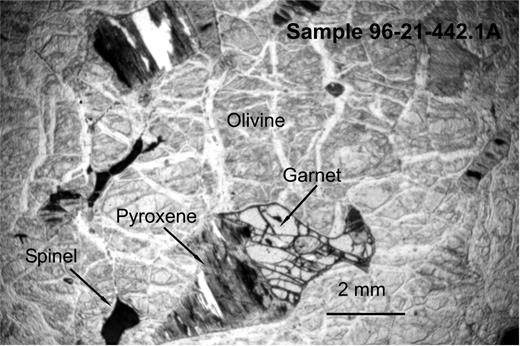
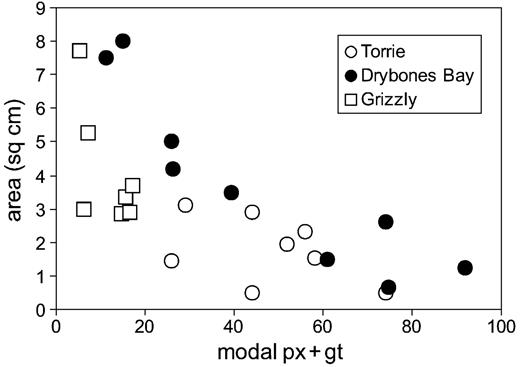
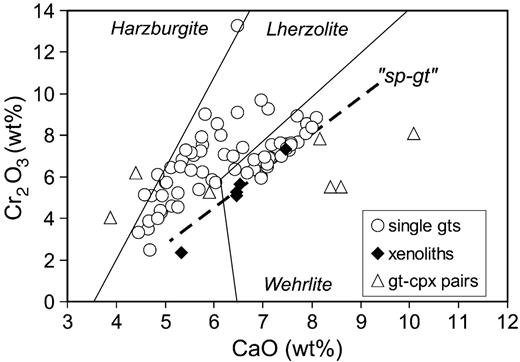
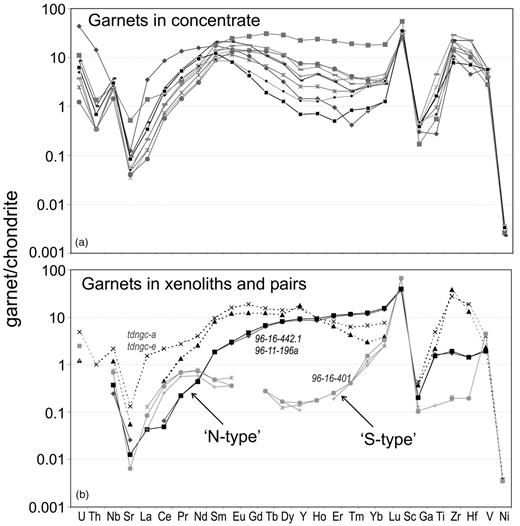
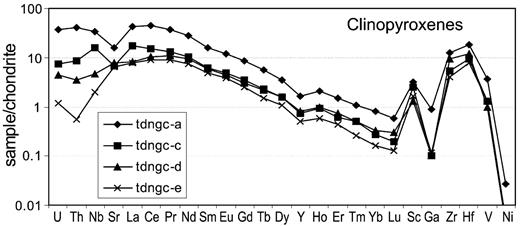
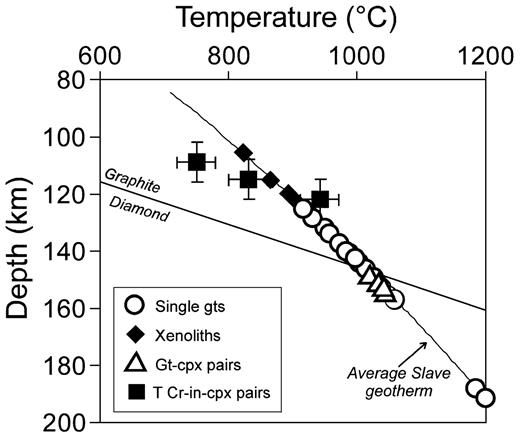
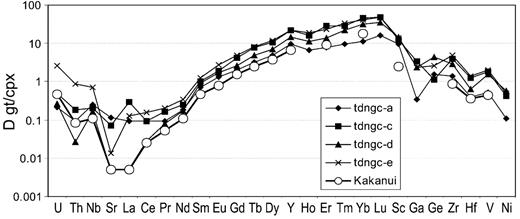
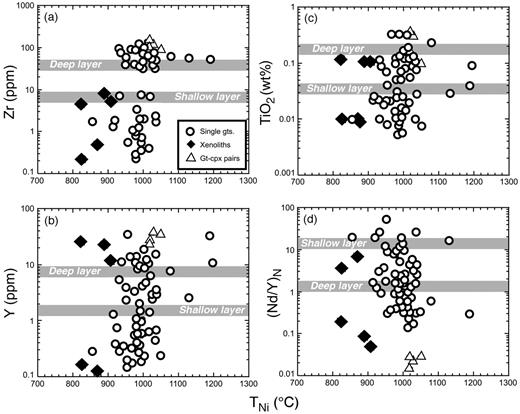
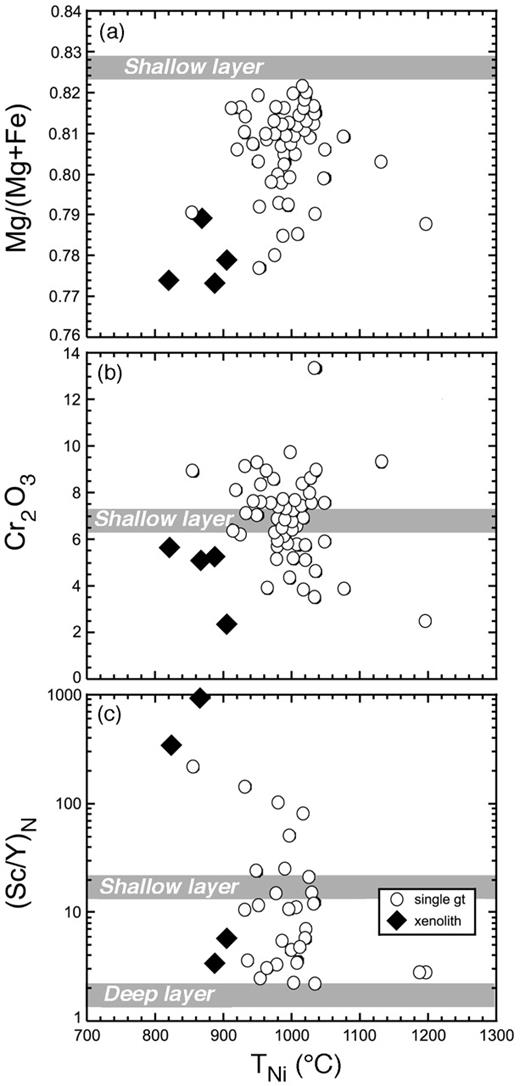
![(a) Covariation of Y with Al2O3 in a large database of natural spinel and garnet peridotites [see Canil & Fedortchouk (2000) for data sources]. The trend is attributed to melt extraction from primitive upper mantle (PUM, McDonough & Sun, 1995) with the change in slope at ∼2 wt % Al2O3 signifying clinopyroxene exhaustion in the source during partial melting to form harzburgite. (b) Calculated covariation of Y with Al2O3 based on isobaric, equilibrium melting reactions along the peridotite solidus at 2, 3 and 7 GPa (Kinzler & Grove, 1992; Walter, 1998) and a maximum DYcrystal/liq measured by experiment for olivine, orthopyroxene, clinopyroxene, garnet and spinel in basaltic or ultramafic systems (Green, 1994). The calculated residue trends (grey lines) have a similar topology to that of natural residues (grey shaded field) but are shifted to higher Al2O3 because melting in nature is polybaric and fractional (not equilibrium and batch as assumed here). The maximum Y contents of garnets that crystallize from the bulk residues at various pressures (continuous lines) are estimated assuming all Y partitions into this mineral and that it makes up only 5% of the mode. The trends show how garnets with <1 ppm Y are expected in very depleted harzburgite residues.](https://oup.silverchair-cdn.com/oup/backfile/Content_public/Journal/petrology/43/1/10.1093_petrology_43.1.129/3/m_egf006.f12.jpeg?Expires=1717066449&Signature=cpNJn3rOb8oUIj-HBjKjS0XDlzzXEYveEsEEhtjbnlHpioZddkIn8E2TifS0GrkDBDbx~4r7z2u8OVptjGdJOQdiLz9DvLG1G~z0p1h~0Ncrb1ja6ezd~YydblzRhLqxhbLx950~Z3266gdl6JOJY7QIjDRkJiP-PfpMZgezT-SaUA1vqWIqX8i~89J7iBl6CpypCbMh57w~owYfYHHz8vCgzCYaUKjbzGQTREdOA5abRrAPeR05TlSxOOXR-bVtJD0ppi2dul1tkG1VZVlmCIEOXHhpfr9cbovXnfS2tXn5teJTMK61jLnTEChWabxX0OU7uDNoXRtJ3ok7t5wpKA__&Key-Pair-Id=APKAIE5G5CRDK6RD3PGA)
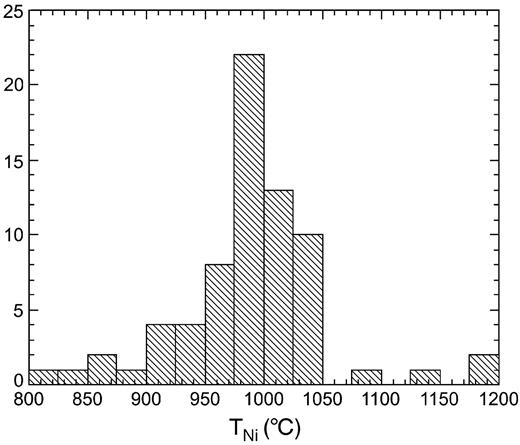
![Present-day cross-section [adapted from Bostock (1998)] of the SW Slave craton drawn by merging geophysical interpretation of deep seismic reflections on SNORCLE line 1 (shaded terranes on left; Cook et al., 1998) with a high-resolution teleseismic image below station YKA (shadowgram to right of cross-section; Bostock, 1998). Locations of the SNORCLE line and station YKA are shown in Fig. 1. It should be noted how the location of the ‘X’ discontinuity (dark ribbon-like feature labelled in the shadowgram) beginning at a depth of ∼110 km in the YKA profile coincides with the onset of order-of-magnitude changes in the trace element geochemistry in Drybones Bay garnets, shown here by Zr in garnet over a depth interval of <50 km (see also Figs 10 and 11).](https://oup.silverchair-cdn.com/oup/backfile/Content_public/Journal/petrology/43/1/10.1093_petrology_43.1.129/3/m_egf006.f13.jpeg?Expires=1717066449&Signature=XZ0ko7YMEr1nKWSle3ztNO4HWWrxpeDRY9Oa0iFUXkSQmBuxJADStpx3Z6bQ2FFC~Y3kPFU5BtuLCmmV6-JNnKSUh3SySWNz1fAaF-emrsxxLR0Vdvx1VoeLgSeVNgPkCPJoKTj3lG91vFrCpk2IduB-DYVdyl7FkbGe0F0u-tyRaytlGplI3j82ZoYAq90uHEYODHzWAqt52w~WA3M72Zp1beju5u-Nk-b~wfFv~SqoGhw4SEdW~s30bPRJxoeauXhQhTOBsvfCKfMBuUAXNZTlW4NXRa4Z2IKiIqeiBMzC8gIEpeH7iQAFNy9YxRBvXLU~E9q43xPmITEkAQkbAA__&Key-Pair-Id=APKAIE5G5CRDK6RD3PGA)
